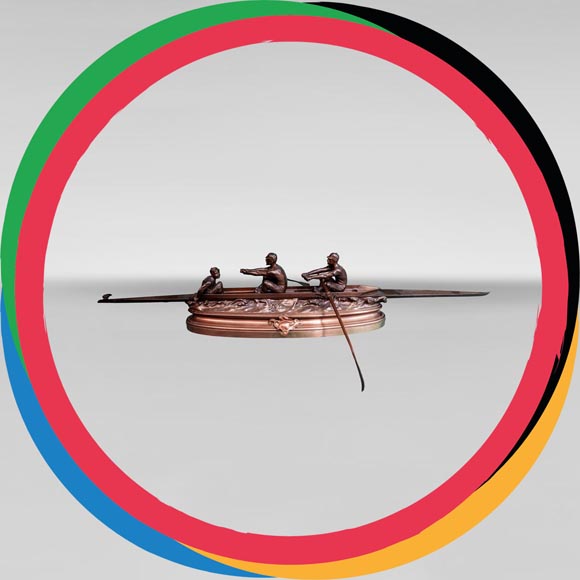Style Other / Ref.15972
Édouard DROUOT, The Rowers, circa 1890
Dimensions
Width 35'' ⅞ 91cm
Height 7'' ⅛ 18cm
Depth: 5'' ½ 14cm
Origin:
19th century
Status:
Good condition
This work was executed by Édouard Drouot around 1880.
The sculptor Édouard Drouot (Sommevoire, 1859-Paris, 1945) studied at the École des Arts Décoratifs in 1880 under Mathurin Moreau; three years later, he was admitted to the École des Beaux-Arts de Paris. He participated in numerous exhibitions, notably at the Salon des Artistes Français, and was rewarded several times. Drouot was famous for his sense of movement, evident in this sporting work, although this subject stands as an exception in his oeuvre.
On a fine, elongated rowing boat stand two rowers and a coxswain steering the boat; it is thus a "coxed pair". The representation is very realistic: the athletes are in the precise position that marks the transition between the "recovery" (oars out of the water) and the "drive" that propels the skiff forward: knees bent, arms extended; their synchronization, which must be perfect, is revealed by the identical nature of their positions. The athletes wear a t-shirt and shorts while the coxswain, who was often small in size to avoid being an excessive weight, is dressed in a shirt and trousers. The curvature of the oars is represented with precision, as is the equipment that holds them attached to the boat. The sculptor takes particular care in the expression of the characters: the young boy displays a radiant face, while the two athletes, with carefully individualized features, focus on the sporting performance to be achieved.
As in this work, racing boats are very long and narrow to reduce resistance due to friction on the water. The rowers sit with their backs to the direction of travel on a sliding seat that accompanies their movements, enhancing the power of their strokes. The oars are the blades used to propel the boat. Rowing is a complete sport, engaging all the muscles.
The earliest rowing races were certainly very ancient: Virgil mentions one in the Aeneid at the end of the 1st century BC. The first modern races took place in the second half of the 18th century, among professional rowers who operated as water taxis on the Thames in London; from that point, the United Kingdom became the privileged stage for the development of these competitions. When the first modern Olympic Games were held in Athens under the impetus of Baron Pierre de Coubertin in 1896, rowing was immediately included among the Olympic disciplines.
There are several other statuettes almost identical to ours, except for some differences in the bases and plaques. Perhaps these works were distributed as prizes at various rowing competitions.
Edouard Drouot also created another sculpture on a related theme, entitled The Canoeists. This slightly later version, dated around 1900, depicts two rowers in a canoe. Unlike rowers, canoeists face the direction they are heading, thus looking far ahead.
Informations
Price: on request
Recommended for you :
Dimensions:
Width: 10
Height: 24
Depth: 11
Dimensions:
Width: 8
Height: 35
Depth: 10
Dimensions:
Width: 8
Height: 23
Depth: 14
Dimensions:
Width: 72
Height: 31
Depth: 18
Dimensions:
Width: 15
Height: 14
Depth: 7
Dimensions:
Width: 55
Height: 174
Depth: 28
Dimensions:
Width: 28
Height: 122
Depth: 26
Dimensions:
Width: 82
Height: 21
Depth: 12
Dimensions:
Width: 23
Height: 38
Depth: 11
Dimensions:
Width: 57
Height: 145
Depth: 20
Dimensions:
Width: 28
Height: 90
Depth: 27
Dimensions:
Width: 47
Height: 23
Depth: 26















